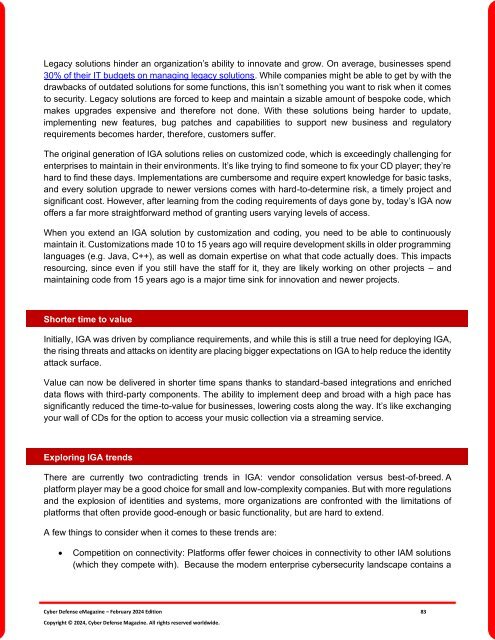The Cyber Defense eMagazine February Edition for 2024
Cyber Defense eMagazine February Edition for 2024 #CDM #CYBERDEFENSEMAG @CyberDefenseMag by @Miliefsky a world-renowned cyber security expert and the Publisher of Cyber Defense Magazine as part of the Cyber Defense Media Group as well as Yan Ross, Editor-in-Chief and many more writers, partners and supporters who make this an awesome publication! 155 page February Edition fully packed with some of our best content. Thank you all and to our readers! OSINT ROCKS! #CDM #CDMG #OSINT #CYBERSECURITY #INFOSEC #BEST #PRACTICES #TIPS #TECHNIQUES
Cyber Defense eMagazine February Edition for 2024 #CDM #CYBERDEFENSEMAG @CyberDefenseMag by @Miliefsky a world-renowned cyber security expert and the Publisher of Cyber Defense Magazine as part of the Cyber Defense Media Group as well as Yan Ross, Editor-in-Chief and many more writers, partners and supporters who make this an awesome publication! 155 page February Edition fully packed with some of our best content. Thank you all and to our readers! OSINT ROCKS! #CDM #CDMG #OSINT #CYBERSECURITY #INFOSEC #BEST #PRACTICES #TIPS #TECHNIQUES
You also want an ePaper? Increase the reach of your titles
YUMPU automatically turns print PDFs into web optimized ePapers that Google loves.
Legacy solutions hinder an organization’s ability to innovate and grow. On average, businesses spend<br />
30% of their IT budgets on managing legacy solutions. While companies might be able to get by with the<br />
drawbacks of outdated solutions <strong>for</strong> some functions, this isn’t something you want to risk when it comes<br />
to security. Legacy solutions are <strong>for</strong>ced to keep and maintain a sizable amount of bespoke code, which<br />
makes upgrades expensive and there<strong>for</strong>e not done. With these solutions being harder to update,<br />
implementing new features, bug patches and capabilities to support new business and regulatory<br />
requirements becomes harder, there<strong>for</strong>e, customers suffer.<br />
<strong>The</strong> original generation of IGA solutions relies on customized code, which is exceedingly challenging <strong>for</strong><br />
enterprises to maintain in their environments. It’s like trying to find someone to fix your CD player; they’re<br />
hard to find these days. Implementations are cumbersome and require expert knowledge <strong>for</strong> basic tasks,<br />
and every solution upgrade to newer versions comes with hard-to-determine risk, a timely project and<br />
significant cost. However, after learning from the coding requirements of days gone by, today’s IGA now<br />
offers a far more straight<strong>for</strong>ward method of granting users varying levels of access.<br />
When you extend an IGA solution by customization and coding, you need to be able to continuously<br />
maintain it. Customizations made 10 to 15 years ago will require development skills in older programming<br />
languages (e.g. Java, C++), as well as domain expertise on what that code actually does. This impacts<br />
resourcing, since even if you still have the staff <strong>for</strong> it, they are likely working on other projects – and<br />
maintaining code from 15 years ago is a major time sink <strong>for</strong> innovation and newer projects.<br />
Shorter time to value<br />
Initially, IGA was driven by compliance requirements, and while this is still a true need <strong>for</strong> deploying IGA,<br />
the rising threats and attacks on identity are placing bigger expectations on IGA to help reduce the identity<br />
attack surface.<br />
Value can now be delivered in shorter time spans thanks to standard-based integrations and enriched<br />
data flows with third-party components. <strong>The</strong> ability to implement deep and broad with a high pace has<br />
significantly reduced the time-to-value <strong>for</strong> businesses, lowering costs along the way. It’s like exchanging<br />
your wall of CDs <strong>for</strong> the option to access your music collection via a streaming service.<br />
Exploring IGA trends<br />
<strong>The</strong>re are currently two contradicting trends in IGA: vendor consolidation versus best-of-breed. A<br />
plat<strong>for</strong>m player may be a good choice <strong>for</strong> small and low-complexity companies. But with more regulations<br />
and the explosion of identities and systems, more organizations are confronted with the limitations of<br />
plat<strong>for</strong>ms that often provide good-enough or basic functionality, but are hard to extend.<br />
A few things to consider when it comes to these trends are:<br />
• Competition on connectivity: Plat<strong>for</strong>ms offer fewer choices in connectivity to other IAM solutions<br />
(which they compete with). Because the modern enterprise cybersecurity landscape contains a<br />
<strong>Cyber</strong> <strong>Defense</strong> <strong>eMagazine</strong> – <strong>February</strong> <strong>2024</strong> <strong>Edition</strong> 83<br />
Copyright © <strong>2024</strong>, <strong>Cyber</strong> <strong>Defense</strong> Magazine. All rights reserved worldwide.

















